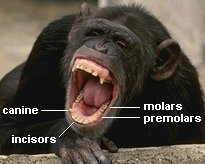Which Animal Is An Ectotherm? Whale Turtle Eagle Kangaroo
The subphylum Vertebrata ![]() includes all of the familiar large animals and some rare and unusual ones too. The 7 living classes of vertebrates are distinguished mostly on the basis of their skeletal system, general environmental accommodation, and reproductive system.
includes all of the familiar large animals and some rare and unusual ones too. The 7 living classes of vertebrates are distinguished mostly on the basis of their skeletal system, general environmental accommodation, and reproductive system.
| subphylum: | Vertebrata | ||||||
| class: | Agnatha | Chondrichthyes | Osteichthyes | Amphibia | Reptilia | Aves | Mammalia |
Three of the vertebrate classes are fish. The most primitive of these is Agnatha ![]() . Information technology consists of jawless fish that do not take scaledue south. These are the lampreys and hagfish. Fish that have skeletons consisting of difficult rubber-like cartilage rather than os are members of the class Chondrichthyes
. Information technology consists of jawless fish that do not take scaledue south. These are the lampreys and hagfish. Fish that have skeletons consisting of difficult rubber-like cartilage rather than os are members of the class Chondrichthyes ![]() . These are the sharks and rays. All of the bony fish are members of the course Osteichthyes
. These are the sharks and rays. All of the bony fish are members of the course Osteichthyes ![]() . Tuna, bass, salmon, and trout are examples of Osteichthyes.
. Tuna, bass, salmon, and trout are examples of Osteichthyes.
 |
| Ray (grade Chondrichthyes) and bony fish (form Osteichthyes) |
Animals in the class Amphibia ![]() spend part of their lives nether water and part on state. Frogs, toads, and salamanders are amphibians. Many of these species must keep their skin moist past periodically returning to moisture areas. All of them must return to water in order to reproduce because their eggs would dry out otherwise. They commencement life with gills, like fish, and later on develop lungs to breathe air.
spend part of their lives nether water and part on state. Frogs, toads, and salamanders are amphibians. Many of these species must keep their skin moist past periodically returning to moisture areas. All of them must return to water in order to reproduce because their eggs would dry out otherwise. They commencement life with gills, like fish, and later on develop lungs to breathe air.
 |
| Salamander and frog (class Amphibia) |
The class Reptilia ![]() includes turtles, snakes, lizards, alligators, and other large reptiles. All of them have lungs to breathe on state and skin that does not need to exist kept moisture. They produce an amniote
includes turtles, snakes, lizards, alligators, and other large reptiles. All of them have lungs to breathe on state and skin that does not need to exist kept moisture. They produce an amniote ![]() egg which ordinarily has a calcium carbonate rich, leather hard trounce that protects the embryo from drying out. This is an advantage over fish and amphibians because the amniote egg tin be laid on land where it is usually safer from predators than it would be in lakes, rivers, and oceans.
egg which ordinarily has a calcium carbonate rich, leather hard trounce that protects the embryo from drying out. This is an advantage over fish and amphibians because the amniote egg tin be laid on land where it is usually safer from predators than it would be in lakes, rivers, and oceans.
The class Aves ![]() includes all the birds. They too produce amniote eggs merely usually give them greater protection from predators by laying them high off of the ground or in other relatively inaccessible locations. In the case of both reptiles and birds, the eggs are fertilized within the reproductive tract of females. In that location are other hit similarities between reptiles and birds in their anatomies and reproductive systems. This is non surprising considering birds are descendents of theropod dinosaurs (ii-legged mostly carnivorous dinosaurs).
includes all the birds. They too produce amniote eggs merely usually give them greater protection from predators by laying them high off of the ground or in other relatively inaccessible locations. In the case of both reptiles and birds, the eggs are fertilized within the reproductive tract of females. In that location are other hit similarities between reptiles and birds in their anatomies and reproductive systems. This is non surprising considering birds are descendents of theropod dinosaurs (ii-legged mostly carnivorous dinosaurs).
 |
| Birds (class Aves) |
Dogs, cats, bears, humans and most other large animals today are members of the vertebrate class Mammalia ![]() . All mammals excogitate their young within the reproductive tract of the mother and, after nativity, nourish them with milk produced by their mammary glands
. All mammals excogitate their young within the reproductive tract of the mother and, after nativity, nourish them with milk produced by their mammary glands ![]() . Mammals are heterodonts
. Mammals are heterodonts ![]() with stiff jaws. That is to say, they have a variety of specialized teeth (incisors, canines, premolars, and molars). This allows them to chew their food into small pieces before swallowing information technology. Subsequently, they can eat any size plant or animate being. Many reptiles must swallow their casualty whole, which limits them to hunting smaller game.
with stiff jaws. That is to say, they have a variety of specialized teeth (incisors, canines, premolars, and molars). This allows them to chew their food into small pieces before swallowing information technology. Subsequently, they can eat any size plant or animate being. Many reptiles must swallow their casualty whole, which limits them to hunting smaller game.
 |
| Mammalian heterodontism |
Like birds, mammals are endothermic ![]() , or warm blooded. They are able to maintain a relatively constant body temperature regardless of external environmental atmospheric condition mainly by using internal physiological mechanisms. In other words, they are homeothermic , or stable in core torso temperature, as a effect of endothermy. All of the living species of insects, fish, reptiles, and amphibians are ectothermic
, or warm blooded. They are able to maintain a relatively constant body temperature regardless of external environmental atmospheric condition mainly by using internal physiological mechanisms. In other words, they are homeothermic , or stable in core torso temperature, as a effect of endothermy. All of the living species of insects, fish, reptiles, and amphibians are ectothermic ![]() , or common cold blooded. They keep their trunk temperature in a normal range mainly by fugitive exposure to environmental temperature extremes. For instance, reptiles usually remain in shaded areas on hot days to forestall fatal overheating. On cold nights, their lowered body temperature tin cause them to become sluggish and inactive. In contrast, endothermic animals are able to remain active at night and often in the winter when the air temperatures are especially cold. They can too move virtually in the heat of very warm days. This ability almost likely provided an advantage for the early pocket-sized mammals in surviving alongside dinosaurs and other large reptiles, which apparently were mostly ectothermic. The downside of endothermy is the need to swallow far more than calories relative to body size in society to maintain a constant core trunk temperature. Pocket-sized mammals, such as moles with their rapid metabolism rates, must eat insects or other high calorie foods every half 60 minutes or then in order to stay alive. By comparison, common cold blooded rattlesnakes normally eat only once every 3-6 weeks and have been known to become without food for as long as 2 years.
, or common cold blooded. They keep their trunk temperature in a normal range mainly by fugitive exposure to environmental temperature extremes. For instance, reptiles usually remain in shaded areas on hot days to forestall fatal overheating. On cold nights, their lowered body temperature tin cause them to become sluggish and inactive. In contrast, endothermic animals are able to remain active at night and often in the winter when the air temperatures are especially cold. They can too move virtually in the heat of very warm days. This ability almost likely provided an advantage for the early pocket-sized mammals in surviving alongside dinosaurs and other large reptiles, which apparently were mostly ectothermic. The downside of endothermy is the need to swallow far more than calories relative to body size in society to maintain a constant core trunk temperature. Pocket-sized mammals, such as moles with their rapid metabolism rates, must eat insects or other high calorie foods every half 60 minutes or then in order to stay alive. By comparison, common cold blooded rattlesnakes normally eat only once every 3-6 weeks and have been known to become without food for as long as 2 years.
Aiding in mammal trunk temperature control is their insulating pilus and sweat glands. Sweating helps to misemploy estrus by evaporative cooling. Compared to most other country mammals, humans are relatively hairless, just they have far more sweat glands. Mammals have four chambered hearts (like birds), complex nervous systems, and large brains relative to the size of their bodies. This wide range of useful features has made mammals highly adaptive and successful. They first appeared almost 200,000,000 years ago, early on in the age of dinosaurs, and replaced reptiles as the ascendant class of land animals after 65,000,000 years ago. Equally the rapidly changing environment at that time led to the mass extinction of most large reptiles, it left vast evolutionary possibilities which mammals took advantage of past speedily diversifying through adaptive radiation.
Important to mammalian success is their reproductive system. Their bodies took the amniote egg revolution of reptiles and birds one footstep farther. In consequence, the uterus ![]() functions every bit the protective eggshell. Young mammals spend a long catamenia of their early on evolution within their mother'south uterus. Subsequently birth, they are provided with protein and fat rich milk to swallow and are usually protected until maturity. Pregnancy and milk production crave mothers to significantly increase their own calorie consumption in order to provide nutrients for their infantdue south. A nursing human being female normally uses well-nigh 30% of her body's energy only to produce milk.
functions every bit the protective eggshell. Young mammals spend a long catamenia of their early on evolution within their mother'south uterus. Subsequently birth, they are provided with protein and fat rich milk to swallow and are usually protected until maturity. Pregnancy and milk production crave mothers to significantly increase their own calorie consumption in order to provide nutrients for their infantdue south. A nursing human being female normally uses well-nigh 30% of her body's energy only to produce milk.
 |
| Mammalian mother and her infant |
Despite their success, mammals all the same only make up about .iv% of known fauna species. Information technology is humbling to realize that all chordates together are only just over three.7% of known beast species. Past comparison, well over ane/2 of all animal species are insects.
Copyright � 1998-2012 past Dennis O'Neil. All rights reserved.
illustration credits
Source: https://www2.palomar.edu/anthro/animal/animal_4.htm
Posted by: vallierekeisheiled.blogspot.com

0 Response to "Which Animal Is An Ectotherm? Whale Turtle Eagle Kangaroo"
Post a Comment